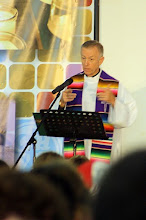Item from the Vatican Press Office:
In
the late morning, the Holy Father Francis received in audience the Domus
Sanctae Marthae the president of the Argentine Republic, Cristina Fernandez de
Kirchner, accompanied by a large delegation.
The
visit had the aim of presenting to the Holy Father the greetings, wishes and
affection of the Argentine people to commemorate the anniversary of the first
year of his pontificate.
The Pope awaited and received the president and
the delegation at the door of the Domus Sanctae Marthae around 1.10 p.m. The
meeting took place in the Hall on the ground floor, first with the entire
delegation, then with the president alone. Then, at around 1.30 p.m., the Pope
and the president lunched privately.
The Holy Father (when Archbishop of Buenos Aires) and the President of Argentina have not always seen eye-to-eye on issues. Yet can one think of a more gracious reception than standing at the door to welcome the officials visitors?
Last year we had a special clergy breakfast reception at 400 Government St for Rabbi James Rudin (who was speaking for the Christian-Jewish Dialogue), and there was Archbishop Rodi, standing at the main entrance to the residence on Franklin St, smiling and waving folks into the parlor. The same sense of warmth and hospitality was shown by our Archbishop and the Holy Father.
These are small gestures, but they speak loudly (and without the need for the proverbial "big stick").
Bl (soon-to-be St) Pope John XXIII was asked, while he was Apostolic Nuncio to France, what was the secret of diplomacy. His response: "A good table and a good cellar are great assets." There's nothing like food & drink. But beyond that, it acknowledges the role of hospitality as fundamental to human relationships: hospitality unfeigned (Caritate non ficta, as Archbishop [Emeritus] Oscar H Lipscomb's motto put it) breaks down barriers far more effectively than dialogue alone. After all, do we or do we not believe that we are all sons and daughters of God, and therefore brothers and sisters?
 12th century mosaics adorn this church, inside and outside: the apse (here) and façade (below) show their majestic beauty to great advantage.
12th century mosaics adorn this church, inside and outside: the apse (here) and façade (below) show their majestic beauty to great advantage.



















